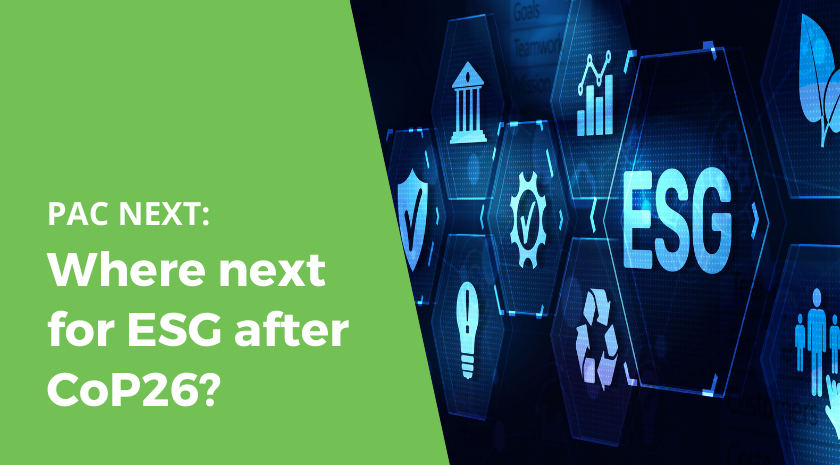From the Desk of Alan Blake, PAC NEXT US Director:
ESG, short for “environmental, social and governance”, has become increasingly top of mind for corporations as they agree to conduct themselves ethically and transparently. And, as you can imagine, there are a range of issues that fall under the ESG umbrella, backed up by external expectations that corporations will “do the right thing”.
So perhaps by taking a look at the outcomes of CoP26, the recent global climate summit held in Glasgow, we can get an idea of where things are going — and then I’ll do my best to tie this all into the world of packaging.
CoP26 (Conference of Parties 26th annual summit) outcomes in a nutshell:
- CO2 emission reduction discussions pushed into 2022, but current pledges, if met, will only limit global warming to 2.4°C vs target of 1.5°C.
- Agreed scheme to cut methane emissions by 30% by 2030 but big emitters China, Russia and India did not join.
- Agreed to phase out fossil fuel subsidies.
- 100 countries with 85% of the world’s forests agreed to stop deforestation by 2030.
- Explicit plan to “phase down” rather than “phase out” use of coal.
- Financial organizations controlling $130 trillion agreed to back “clean” technology.
Click here for a complete conference summary by the International Institute for Sustainable Development.
So how do corporations respond to this? Well, it will boil down to what companies can do, and what they are willing to do, to meet the expectations of their shareholders, employees, customers and communities to protect the planet. And, as a personal commentary, CoP26 offered a “mixed bag” of hope and frustration that will see some governments and corporations stepping up while others lag. I’m particularly proud of my former employer P&G who just launched their 2021 Citizenship Report, which “tells the stories of our ongoing commitments to make a positive impact on our communities, equality and inclusion and the planet we call home. With the help of our brands and partners, we’re using our voice, reach, innovation and expertise to accelerate action on important issues, including climate change, equality and inclusion and the COVID-19 pandemic.”
If we take a look at the world of packaging, what we have seen is a transition from companies setting 2025 / 2030 / 2050 goals (for reduction, reuse, recyclable and / or compostable, recycled and renewable content), to a realization that the only hope of achieving these goals is through collaboration, partnership and investment.
For example, during the past 12 months the US and Canada formed their respective Plastics Pacts to reduce plastic waste and ocean debris. There are also numerous alliances being formed, across all package material types and value chains, to find solutions that can reduce greenhouse gas emissions, increase material and logistics efficiencies and reduce waste (e.g., Alliance to End Plastic Waste; Circular Plastics Taskforce; the European Platform for Reusable Packaging, and many others). In addition, there have been huge investments in advanced recycling technologies (various types of chemical recycling), and joint industry and technology development programs such as Project Holy Grail for digital watermarking.
So the packaging value chain is stepping up – but is it too little too late? Well, there’s no getting away from accountability: 2025 is on our doorstep, 2030 close behind, and perhaps the enormity of the environmental challenge is just starting to sink in? I hope so, and I’m delighted that the PAC Global Team will be utilizing its expertise in circular packaging design, materials waste management, sustainability strategies, Canadian legislation to support companies on this journey. Along with our many education and training opportunities, PAC Global will do this by offering marquee consulting services tailored to companies specific needs.
For more information contact PAC Global CEO James Downham: jdd@leaderlinx.com



